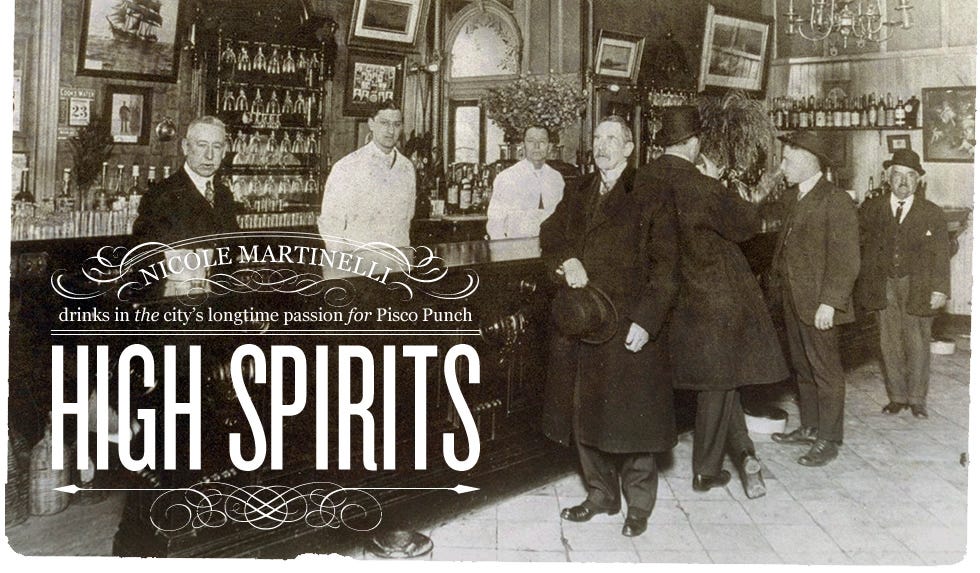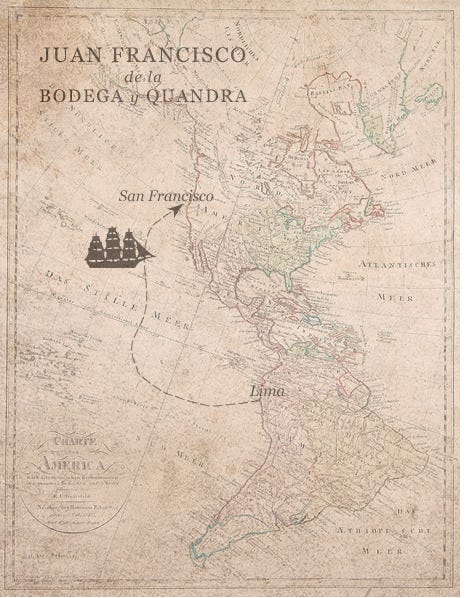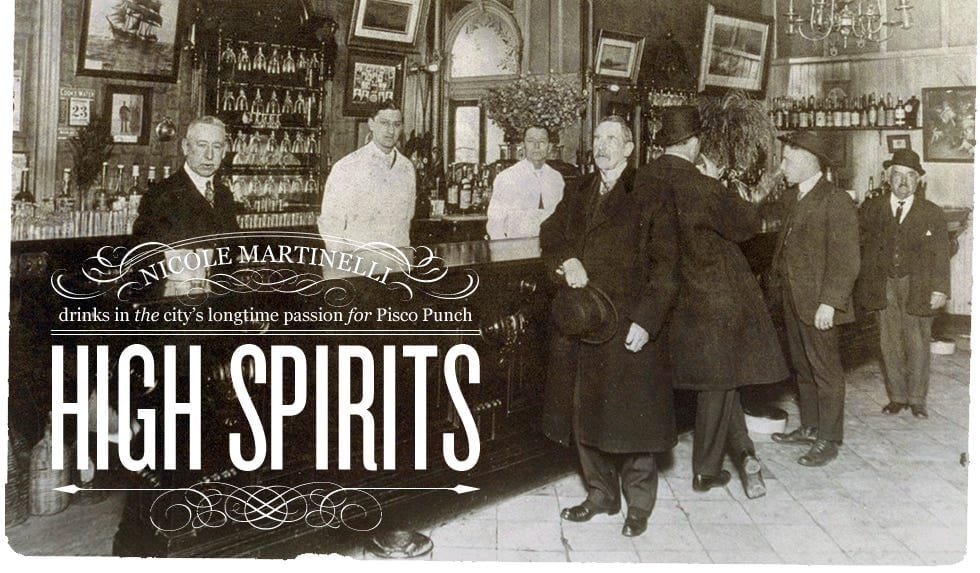
By Nicole Martinelli
This is the first time I’ve waited an hour and 37 minutes for a drink. It’s also the first time I’ve had a cocktail in a church basement with a statue of the Virgin Mary in the corner and a large wooden cross on the wall. It seems a fittingly reverent setting to try San Francisco’s oldest and almost-forgotten drink, Pisco Punch.
I’m first in line to taste after listening to author Guillermo Toro-Lira talk about the mystery drink to members of the San Francisco Museum and Historical Association at St. Philip’s Church on Diamond Street. Guillermo, whose business card describes him as a cocktail historian, dumps a yellowish liquid from large glass jars into a cut-glass bowl, then ladles it carefully over ice into small waxed paper cups. His wife, Brenda, quickly dispatches cups to the 50 or so thirsty history buffs.
Turbid, straw-colored, and with chunks of pineapple bobbing around, Pisco Punch does not look particularly promising, but it goes down like a dream: think fortified lemonade with a spicy kick. It’s the stuff of which mischief is made. The chief ingredient is Pisco, a potent white grape Peruvian brandy, which first reached San Francisco aboard a ship that Spanish captain Juan Francisco de la Bodega y Quadra had retrofitted to hold the precious casks in the 1700s.

I’m a third-generation San Franciscan but caught the Pisco Punch fire only recently. It’s likely that even my grandma Tess, known to mix a mean Pink Lady, wouldn’t have been a big Pisco drinker — the craze dates back to the late 1800s and suffered a mortal blow with Prohibition. Duncan Nicol invented Pisco Punch at the Bank Exchange & Billiard Saloon, which stood where the Transamerica tower does today. Pisco Punch aficionado Rudyard Kipling described it as “compounded of the shavings of cherubs’ wings.”
After feeling a distinct flutter with that first cup, I can only concur. But what’s in it? The original secret recipe is much disputed, but most agree that Pisco Punch is a potent concoction whose basic ingredients are Peruvian Pisco brandy, pineapple, lime juice, gum Arabic, simple syrup, and distilled water. The citrus flavors and sugars shield drinkers from feeling the fruity potency of the brandy (the alcohol content is a head-spinning 76% to 96% proof), hence the danger of quaffing large quantities of it too quickly.
Prohibition proved a booze-kill for the Bank Exchange saloon, and Nicol’s secret recipe most likely went to the grave with him in 1926. But in tracking down information for his book Wings of Cherubs: The Saga of the Rediscovery of Pisco Punch, Old San Francisco’s Mystery Drink , Guillermo found that bottled versions were marketed much like today’s margarita mixes. (His next book due out in fall 2010, A History of Pisco in San Francisco: a Scrapbook of First-Hand Accounts , has some great pictures of bottled punch and more.)

Eager to taste Pisco Punch in a proper glass, I head to Pisco Latin Lounge, a new take on the Pisco-centered watering hole of yore. Guillermo is part owner and resident historian here. Given his spirited enthusiasm for research, I expect to find the place awash in mining paraphernalia and wagon wheels. Looking past the LCD screens playing Euro-pop, red walls, and black lacquer furniture, I notice touches of the past in a tin-patterned ceiling — homage to the Bank Exchange — and replicas of clay Pisco vessels.
I’ve assembled a troop of tasters who have agreed to drink the Punch after hearing of my seraphic experience. The original recipe for Pisco Punch, rediscovered by Guillermo during his research, is the real throwback here. Pisco’s uses this recipe, minus the rumored secret ingredient (cocaine?). Like the version I drank in church, parts of it are made beforehand in mason jars, then each drink is shaken with ice and strained. The Punch combines Viñas de Oro Pisco Italia, pineapple gum (fresh pineapple steeped in a gum Arabic and simple sugar solution), and macerated pineapple. The waiter whisks us a tray of long-stemmed cocktail glasses, each one garnished with a chunk of pineapple.
In it I find total, instant bliss, followed by an outpour of incoherent ramblings that I can only attribute to the alcohol. Fortunately, everyone else in my tasting committee is quickly hopped up on Pisco Punch, too, and no one seems to notice. After a much-needed glass of water, I’m curious to try Pisco straight. The bar stocks about 30 different types, so I settle on Soldeica Pisco Puro, which has some fruity undertones and a nice, smooth texture. Deciding that even angels’ wings won’t make a Muni ride any better, I opt instead to take the 1.5 mile journey home on foot instead.

Head into a bar and chances are there’s a hot guy or gal that the bartenders are plying with their best drinks. I have never been that person, but I know how to spot one. At Cantina, it’s a raven-haired beauty wearing a summer-in-San-Francisco getup of a fitted black sweater with abbreviated black shorts on goose-bumpy bare legs. A bartender hands her a tall, creamy concoction with a splash of purple. “I’ll have what she’s having,” I venture. It’s called a Blushing Lima, and if you like your drinks more sweet than tart, this is the Pisco blend for you: the port balances out the Pisco, lemon, egg white, and Canton ginger.
It won me over — as well as it did the girl, whose meaningful glances at the barkeep were many — but the Pisco Punch at Cantina should not be overlooked for its flashier siblings. Cantina founding partner Duggan McDonnell became besotted enough with the Peruvian brandy to develop a bartender-friendly brand of blended Pisco called Campo de Encantom. The Punch here is made with Campo, crushed pineapple, citrus, Angostura bitters, and ginger brew. Served over lots of ice in a Collins glass, this tangy treat is a spirited twist on classic Pisco Punch, and one of my favorites.


At this point, I know I like Pisco Punch but wonder if I’m like one of those Luddites who says, “I know what I like” about art, but really has no taste. So I ask Lilia — who studied with me in Italy and boasts a Pisco-based drink experience, thanks to working for a spell at a Peruvian restaurant — to meet me at La Mar Cebicheria Peruana. We wrestle two bar stools from the Financial District crowd during a crazed happy hour, where we are delighted to discover that Pisco Punch and Pisco Sours are served for $5 each.
Made with BarSol Pisco and served in a short glass, this straightforward version is made with three ingredients: Pisco Quebranta, pineapple syrup, and lemon juice. Lilia takes a tentative sip, then states that the drink strikes the perfect balance between tart and sweet, just as it should. I gulp the rest of mine down, pleased as punch that she agrees with me. This version is also not so strong as to provide the kind of liquid courage that would make a “gnat fight an elephant,” a quality attributed to the drink back in its heyday. So we decide that we are still sober enough to sample the other interesting Pisco drinks — the ones served in tall glasses for more leisurely sipping.
I choose Pastito (Pisco, lavender extract, Falernum, and pineapple syrup) and Lilia tries an El Diablito (Pisco acholado, ginger syrup, crème de cassis, and ginger beer). Soon we find it easier to speak in Italian and wisely order up marvelous mixed causas before wandering off, gesticulating contentedly.

Students of San Francisco history usually have a favorite colorful character; mine is probably Joshua Abraham Norton, a failed gold rush mogul who appointed himself “Norton I, Emperor of America and Protector of Mexico.” Spotting a stylized statue of him gazing down on me from the vast mahogany bar at Comstock Saloon, I know I’m in the right place for some retro-wishful drinking. Sitting on a velvet-topped barstool that perches on what looks like a metal ostrich leg, I swivel around to drink in the period details (damask-patterned wallpaper, etched light fixtures, a pulley-driven ceiling fan, spittoon, player piano) while waiting for my Pisco Punch to arrive.
Bartender Jonny Raglin, channeling the late 1800s vibe by sporting a skinny, pointed waxed moustache and short checked jacket, mixes up a deceptively simple version that packs a real wallop: Pisco, pineapple gum, and lime. Any more than two of these short but potent chilled versions — since they taste less tempered with citrus and sugar than at other places — means trouble. Like all good Pisco Punch, it goes down very easy. Jonny sees me tilting slightly, raises an eyebrow, gets me a glass of water, and pushes a bar menu my way.
The food looks like it might fuel a mining endeavor, so I order corn and jalapeño fritters and alligator-pear toasts (that’s avocado and grapefruit for you people stuck in the aughts), figuring it’ll be enough to get me home without incident. After eating, I’m perfectly happy-go-lucky. Pisco Punch inventor Nicol was said to refuse patrons more than two drinks at a time for this very reason. By now, though, I’ve learned to taste the mischief of Pisco Punch and harness it. Emperor Norton, who frequented the Bank Exchange saloon where Pisco Punch was invented, would approve.

Pisco Punch is a drink that can inspire carousing; in today’s world it is perhaps best enjoyed during happy hour followed by a sensible meal. Head to Pisco Latin Lounge, Cantina, or La Mar Cebicheria Peruana for said experience.
Guillermo swore me to secrecy about his rediscovered recipe, but you can find it in his book. Just be forewarned that it runs three pages, requires considerable patience and some skill, as well as overnight prep time. For an easy one that tastes similar to what you’ll find in bars, I’m fond of the version that Paul Clarke ( The Cocktail Chronicles ) mixes up:
Pisco Punch
2 ounces Pisco
3/4-ounce fresh lemon or lime juice
3/4-ounce pineapple gum syrup
Combine ingredients in a cocktail shaker and fill with ice. Shake well and strain into a chilled cocktail glass or punch glass.
You can find a variety of Piscos around town at The Jug Shop, Cask, and K & L. The pineapple gum syrup (pineapple-infused gum Arabic syrup) gives the drink some nice added body and viscosity; it can be found online at Small Hand Foods. If you want to get a little jiggy, cut a pineapple into small chunks and macerate it overnight in gum syrup (also available from Small Hand Foods) instead of using the pineapple gum syrup, then serve each glass with a piece of pineapple in it.
Design: Jon Adams







